TORT LAW Assignment: Accident Compensation Act 2001 and Negligence
VerifiedAdded on 2022/11/24
|12
|2608
|229
Report
AI Summary
This assignment comprises a letter of advice and an article addressing TORT LAW principles within the context of the Accident Compensation Act 2001 in New Zealand. The letter is directed to a visiting doctor who sustained severe head injuries in an accident, detailing his potential entitlements under the Act, particularly regarding loss of earnings and rehabilitation. The article, intended for LawTalk, discusses negligence, duty of care, breach of duty, and causation, illustrating these legal concepts through the scenario of the doctor's injury. It examines the elements necessary to prove negligence, referencing key case laws such as Donoghue v Stevenson and Caparo Industries plc v Dickman, and explains the roles of foreseeability, proximity, and fairness in establishing liability. The assignment provides a comprehensive analysis of TORT LAW, combining practical legal advice with a theoretical understanding of negligence and compensation frameworks.
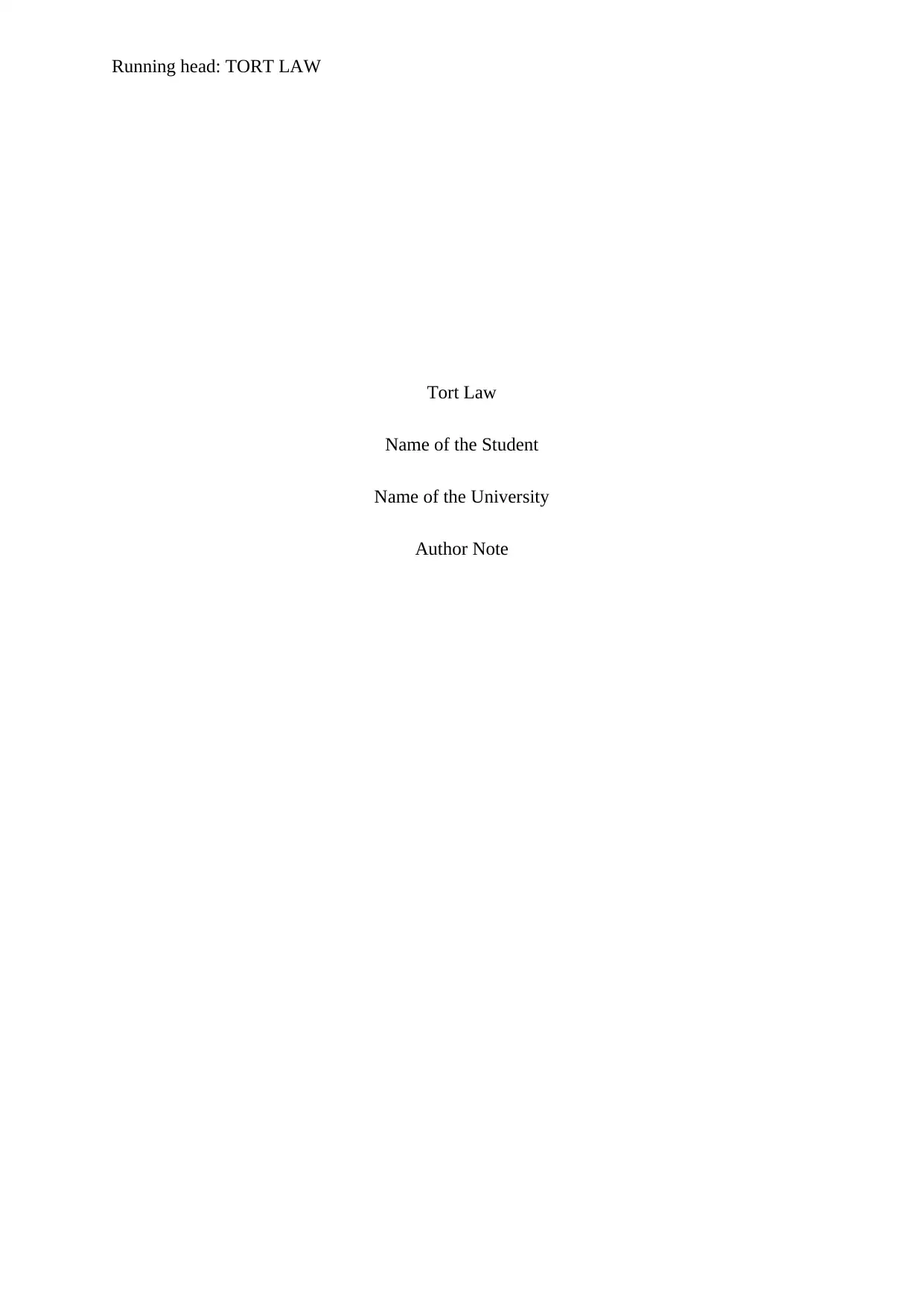
Running head: TORT LAW
Tort Law
Name of the Student
Name of the University
Author Note
Tort Law
Name of the Student
Name of the University
Author Note
Paraphrase This Document
Need a fresh take? Get an instant paraphrase of this document with our AI Paraphraser
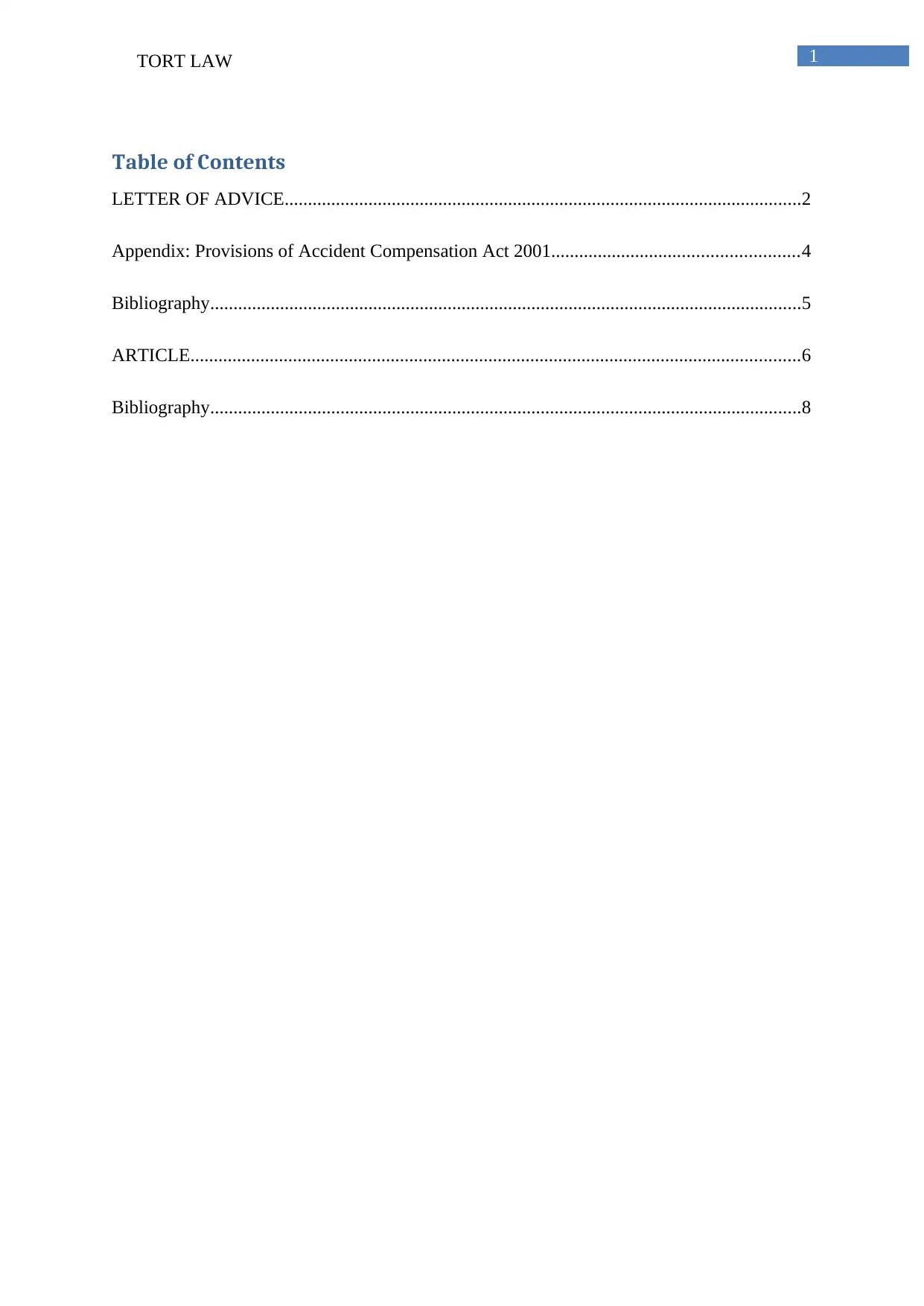
1TORT LAW
Table of Contents
LETTER OF ADVICE...............................................................................................................2
Appendix: Provisions of Accident Compensation Act 2001.....................................................4
Bibliography...............................................................................................................................5
ARTICLE...................................................................................................................................6
Bibliography...............................................................................................................................8
Table of Contents
LETTER OF ADVICE...............................................................................................................2
Appendix: Provisions of Accident Compensation Act 2001.....................................................4
Bibliography...............................................................................................................................5
ARTICLE...................................................................................................................................6
Bibliography...............................................................................................................................8
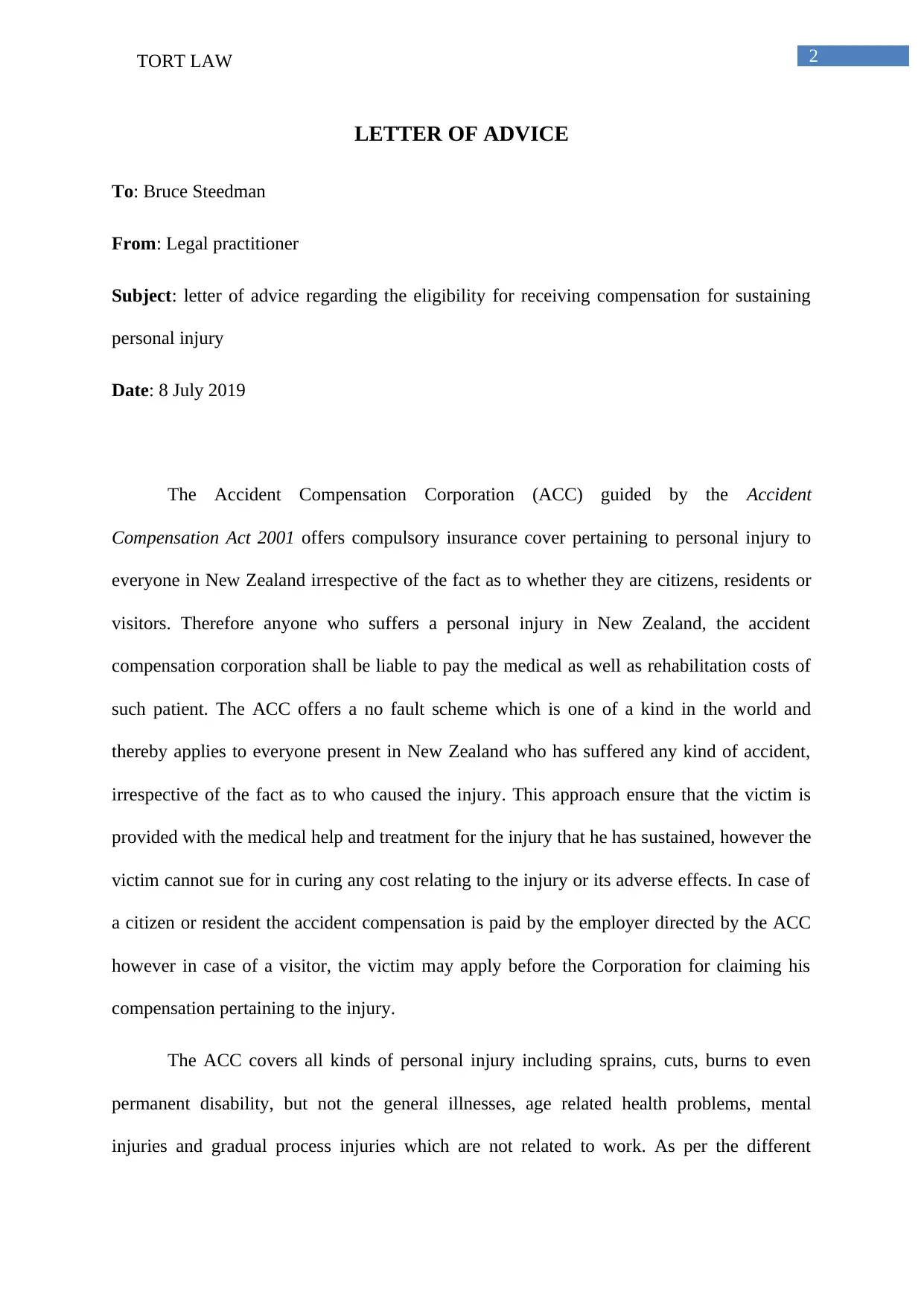
2TORT LAW
LETTER OF ADVICE
To: Bruce Steedman
From: Legal practitioner
Subject: letter of advice regarding the eligibility for receiving compensation for sustaining
personal injury
Date: 8 July 2019
The Accident Compensation Corporation (ACC) guided by the Accident
Compensation Act 2001 offers compulsory insurance cover pertaining to personal injury to
everyone in New Zealand irrespective of the fact as to whether they are citizens, residents or
visitors. Therefore anyone who suffers a personal injury in New Zealand, the accident
compensation corporation shall be liable to pay the medical as well as rehabilitation costs of
such patient. The ACC offers a no fault scheme which is one of a kind in the world and
thereby applies to everyone present in New Zealand who has suffered any kind of accident,
irrespective of the fact as to who caused the injury. This approach ensure that the victim is
provided with the medical help and treatment for the injury that he has sustained, however the
victim cannot sue for in curing any cost relating to the injury or its adverse effects. In case of
a citizen or resident the accident compensation is paid by the employer directed by the ACC
however in case of a visitor, the victim may apply before the Corporation for claiming his
compensation pertaining to the injury.
The ACC covers all kinds of personal injury including sprains, cuts, burns to even
permanent disability, but not the general illnesses, age related health problems, mental
injuries and gradual process injuries which are not related to work. As per the different
LETTER OF ADVICE
To: Bruce Steedman
From: Legal practitioner
Subject: letter of advice regarding the eligibility for receiving compensation for sustaining
personal injury
Date: 8 July 2019
The Accident Compensation Corporation (ACC) guided by the Accident
Compensation Act 2001 offers compulsory insurance cover pertaining to personal injury to
everyone in New Zealand irrespective of the fact as to whether they are citizens, residents or
visitors. Therefore anyone who suffers a personal injury in New Zealand, the accident
compensation corporation shall be liable to pay the medical as well as rehabilitation costs of
such patient. The ACC offers a no fault scheme which is one of a kind in the world and
thereby applies to everyone present in New Zealand who has suffered any kind of accident,
irrespective of the fact as to who caused the injury. This approach ensure that the victim is
provided with the medical help and treatment for the injury that he has sustained, however the
victim cannot sue for in curing any cost relating to the injury or its adverse effects. In case of
a citizen or resident the accident compensation is paid by the employer directed by the ACC
however in case of a visitor, the victim may apply before the Corporation for claiming his
compensation pertaining to the injury.
The ACC covers all kinds of personal injury including sprains, cuts, burns to even
permanent disability, but not the general illnesses, age related health problems, mental
injuries and gradual process injuries which are not related to work. As per the different
⊘ This is a preview!⊘
Do you want full access?
Subscribe today to unlock all pages.

Trusted by 1+ million students worldwide
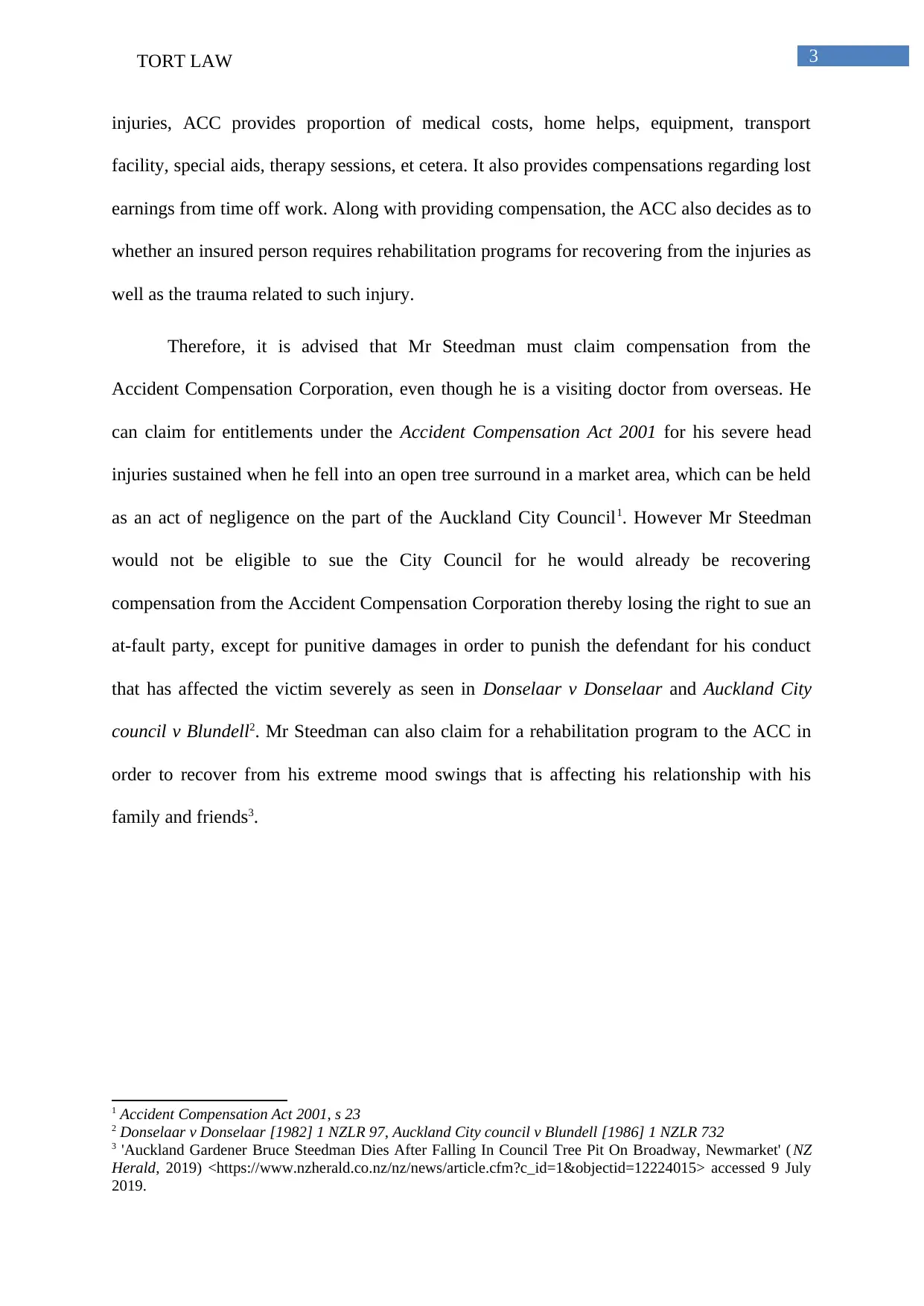
3TORT LAW
injuries, ACC provides proportion of medical costs, home helps, equipment, transport
facility, special aids, therapy sessions, et cetera. It also provides compensations regarding lost
earnings from time off work. Along with providing compensation, the ACC also decides as to
whether an insured person requires rehabilitation programs for recovering from the injuries as
well as the trauma related to such injury.
Therefore, it is advised that Mr Steedman must claim compensation from the
Accident Compensation Corporation, even though he is a visiting doctor from overseas. He
can claim for entitlements under the Accident Compensation Act 2001 for his severe head
injuries sustained when he fell into an open tree surround in a market area, which can be held
as an act of negligence on the part of the Auckland City Council1. However Mr Steedman
would not be eligible to sue the City Council for he would already be recovering
compensation from the Accident Compensation Corporation thereby losing the right to sue an
at-fault party, except for punitive damages in order to punish the defendant for his conduct
that has affected the victim severely as seen in Donselaar v Donselaar and Auckland City
council v Blundell2. Mr Steedman can also claim for a rehabilitation program to the ACC in
order to recover from his extreme mood swings that is affecting his relationship with his
family and friends3.
1 Accident Compensation Act 2001, s 23
2 Donselaar v Donselaar [1982] 1 NZLR 97, Auckland City council v Blundell [1986] 1 NZLR 732
3 'Auckland Gardener Bruce Steedman Dies After Falling In Council Tree Pit On Broadway, Newmarket' ( NZ
Herald, 2019) <https://www.nzherald.co.nz/nz/news/article.cfm?c_id=1&objectid=12224015> accessed 9 July
2019.
injuries, ACC provides proportion of medical costs, home helps, equipment, transport
facility, special aids, therapy sessions, et cetera. It also provides compensations regarding lost
earnings from time off work. Along with providing compensation, the ACC also decides as to
whether an insured person requires rehabilitation programs for recovering from the injuries as
well as the trauma related to such injury.
Therefore, it is advised that Mr Steedman must claim compensation from the
Accident Compensation Corporation, even though he is a visiting doctor from overseas. He
can claim for entitlements under the Accident Compensation Act 2001 for his severe head
injuries sustained when he fell into an open tree surround in a market area, which can be held
as an act of negligence on the part of the Auckland City Council1. However Mr Steedman
would not be eligible to sue the City Council for he would already be recovering
compensation from the Accident Compensation Corporation thereby losing the right to sue an
at-fault party, except for punitive damages in order to punish the defendant for his conduct
that has affected the victim severely as seen in Donselaar v Donselaar and Auckland City
council v Blundell2. Mr Steedman can also claim for a rehabilitation program to the ACC in
order to recover from his extreme mood swings that is affecting his relationship with his
family and friends3.
1 Accident Compensation Act 2001, s 23
2 Donselaar v Donselaar [1982] 1 NZLR 97, Auckland City council v Blundell [1986] 1 NZLR 732
3 'Auckland Gardener Bruce Steedman Dies After Falling In Council Tree Pit On Broadway, Newmarket' ( NZ
Herald, 2019) <https://www.nzherald.co.nz/nz/news/article.cfm?c_id=1&objectid=12224015> accessed 9 July
2019.
Paraphrase This Document
Need a fresh take? Get an instant paraphrase of this document with our AI Paraphraser
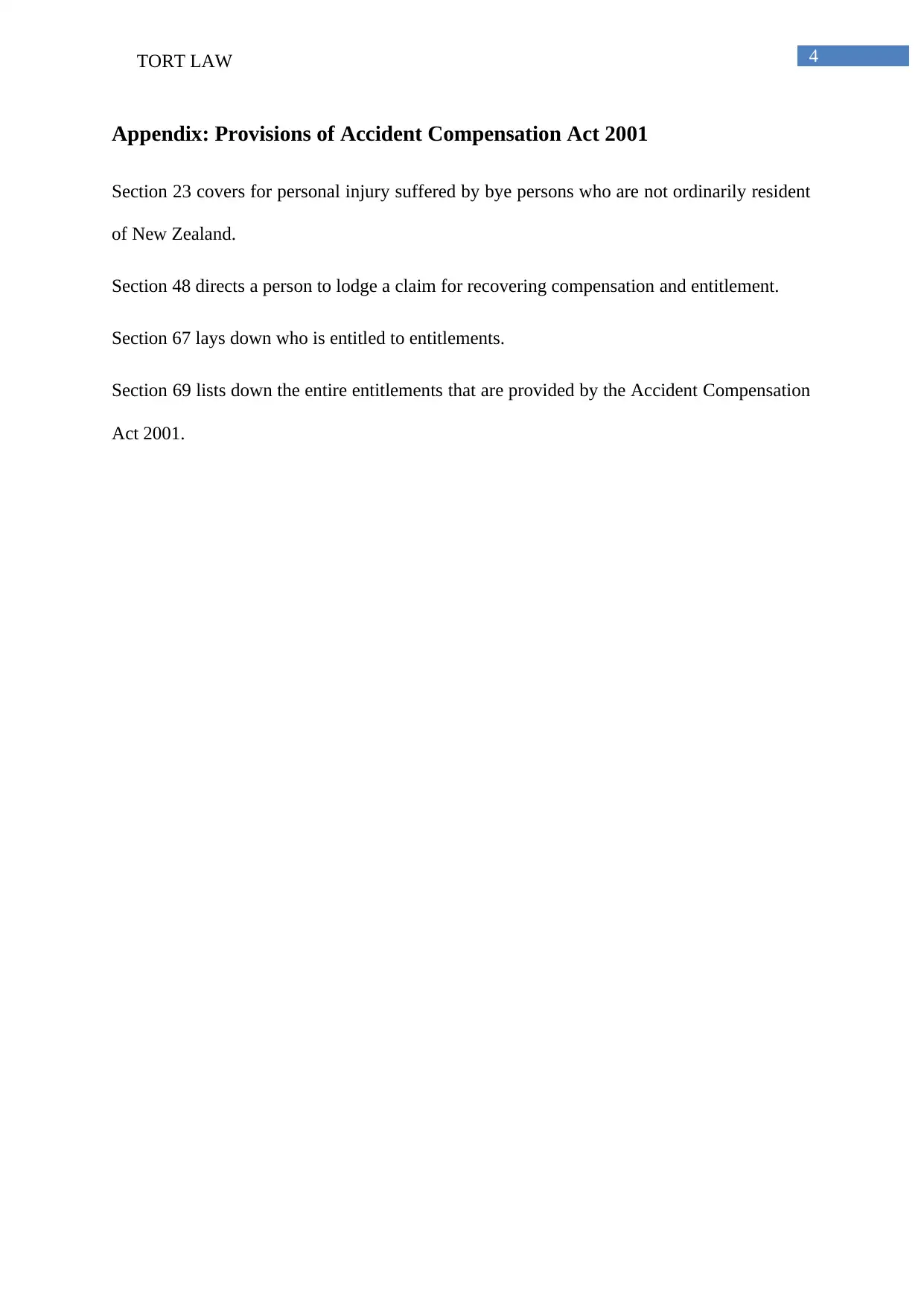
4TORT LAW
Appendix: Provisions of Accident Compensation Act 2001
Section 23 covers for personal injury suffered by bye persons who are not ordinarily resident
of New Zealand.
Section 48 directs a person to lodge a claim for recovering compensation and entitlement.
Section 67 lays down who is entitled to entitlements.
Section 69 lists down the entire entitlements that are provided by the Accident Compensation
Act 2001.
Appendix: Provisions of Accident Compensation Act 2001
Section 23 covers for personal injury suffered by bye persons who are not ordinarily resident
of New Zealand.
Section 48 directs a person to lodge a claim for recovering compensation and entitlement.
Section 67 lays down who is entitled to entitlements.
Section 69 lists down the entire entitlements that are provided by the Accident Compensation
Act 2001.
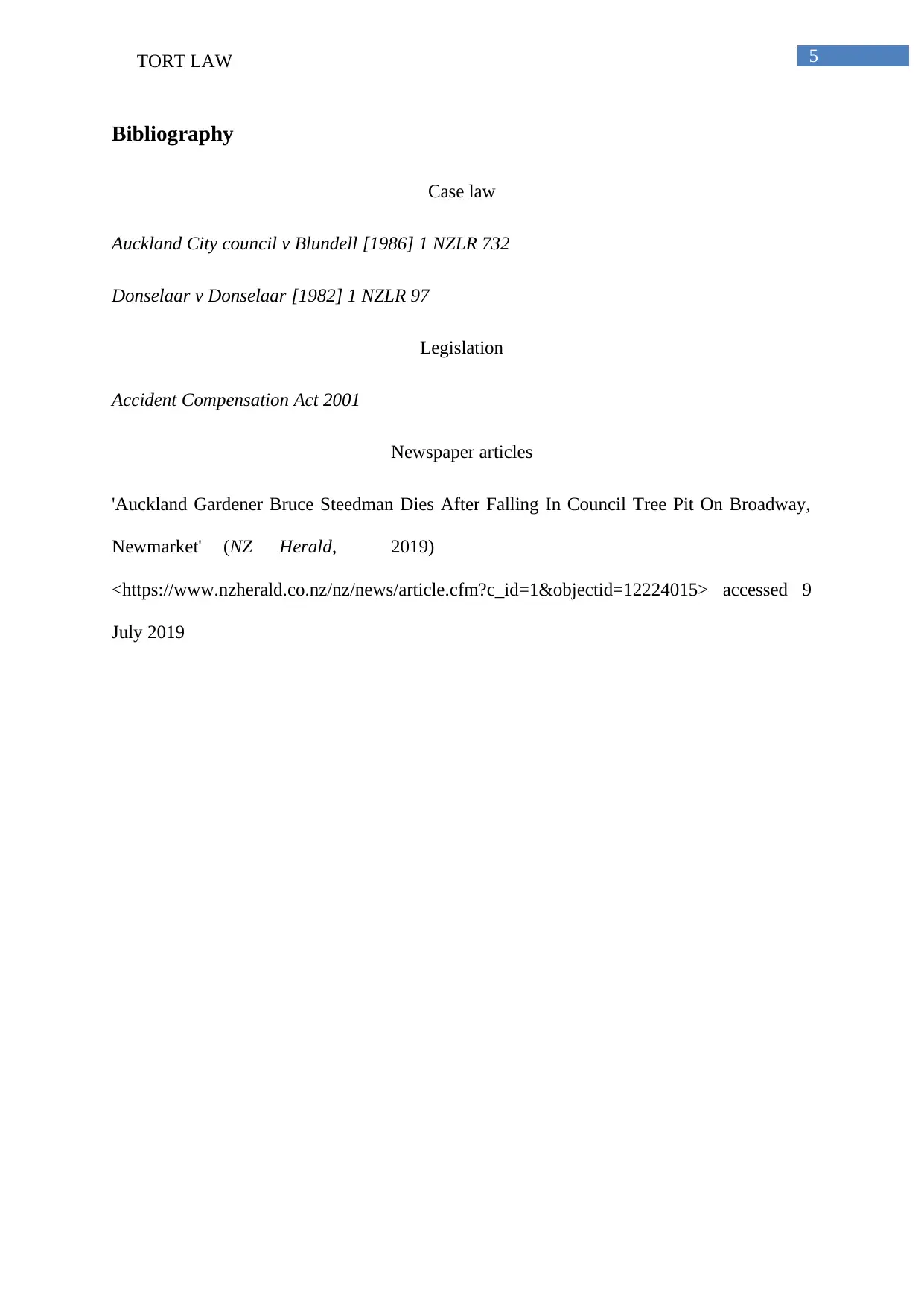
5TORT LAW
Bibliography
Case law
Auckland City council v Blundell [1986] 1 NZLR 732
Donselaar v Donselaar [1982] 1 NZLR 97
Legislation
Accident Compensation Act 2001
Newspaper articles
'Auckland Gardener Bruce Steedman Dies After Falling In Council Tree Pit On Broadway,
Newmarket' (NZ Herald, 2019)
<https://www.nzherald.co.nz/nz/news/article.cfm?c_id=1&objectid=12224015> accessed 9
July 2019
Bibliography
Case law
Auckland City council v Blundell [1986] 1 NZLR 732
Donselaar v Donselaar [1982] 1 NZLR 97
Legislation
Accident Compensation Act 2001
Newspaper articles
'Auckland Gardener Bruce Steedman Dies After Falling In Council Tree Pit On Broadway,
Newmarket' (NZ Herald, 2019)
<https://www.nzherald.co.nz/nz/news/article.cfm?c_id=1&objectid=12224015> accessed 9
July 2019
⊘ This is a preview!⊘
Do you want full access?
Subscribe today to unlock all pages.

Trusted by 1+ million students worldwide
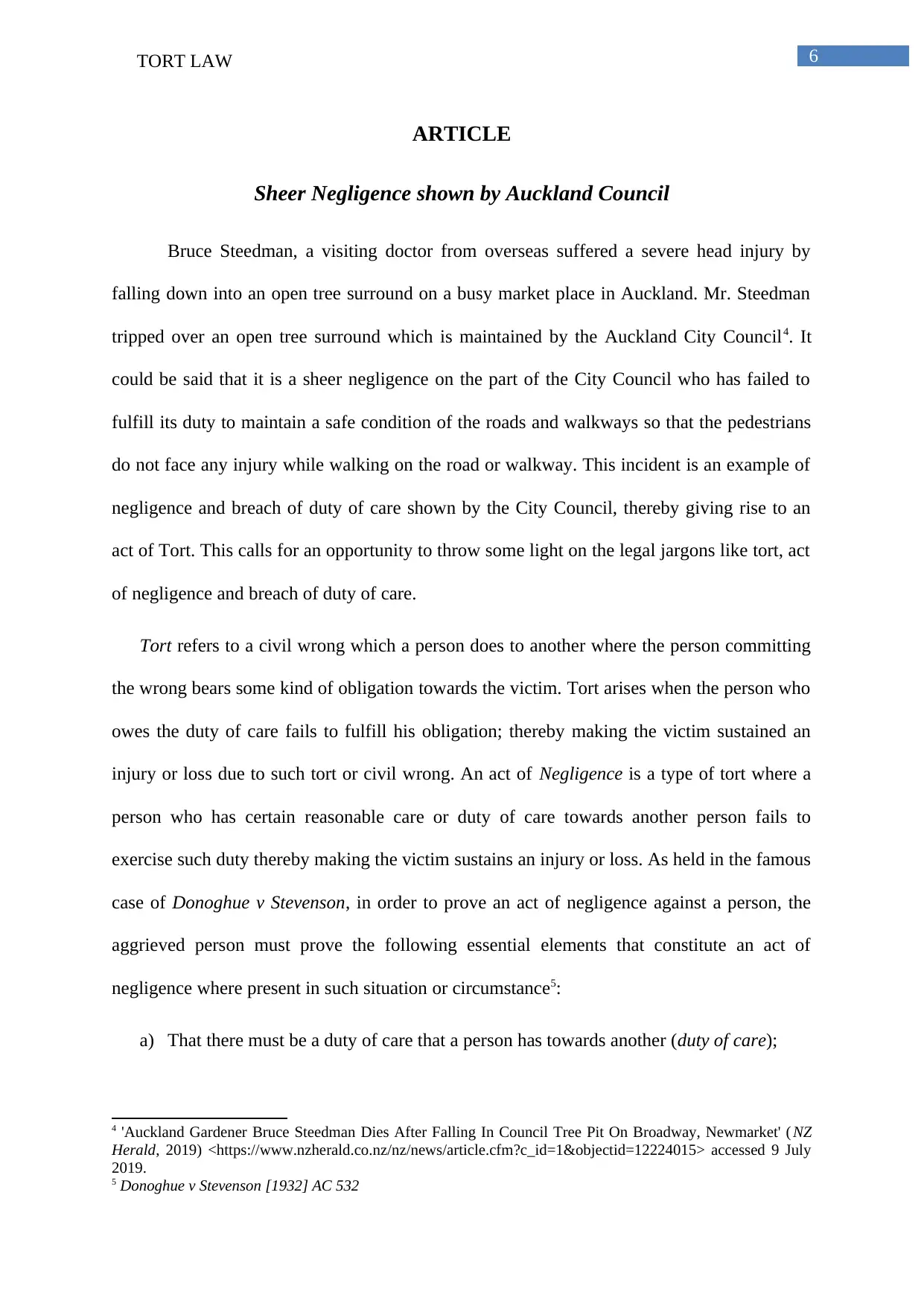
6TORT LAW
ARTICLE
Sheer Negligence shown by Auckland Council
Bruce Steedman, a visiting doctor from overseas suffered a severe head injury by
falling down into an open tree surround on a busy market place in Auckland. Mr. Steedman
tripped over an open tree surround which is maintained by the Auckland City Council4. It
could be said that it is a sheer negligence on the part of the City Council who has failed to
fulfill its duty to maintain a safe condition of the roads and walkways so that the pedestrians
do not face any injury while walking on the road or walkway. This incident is an example of
negligence and breach of duty of care shown by the City Council, thereby giving rise to an
act of Tort. This calls for an opportunity to throw some light on the legal jargons like tort, act
of negligence and breach of duty of care.
Tort refers to a civil wrong which a person does to another where the person committing
the wrong bears some kind of obligation towards the victim. Tort arises when the person who
owes the duty of care fails to fulfill his obligation; thereby making the victim sustained an
injury or loss due to such tort or civil wrong. An act of Negligence is a type of tort where a
person who has certain reasonable care or duty of care towards another person fails to
exercise such duty thereby making the victim sustains an injury or loss. As held in the famous
case of Donoghue v Stevenson, in order to prove an act of negligence against a person, the
aggrieved person must prove the following essential elements that constitute an act of
negligence where present in such situation or circumstance5:
a) That there must be a duty of care that a person has towards another (duty of care);
4 'Auckland Gardener Bruce Steedman Dies After Falling In Council Tree Pit On Broadway, Newmarket' ( NZ
Herald, 2019) <https://www.nzherald.co.nz/nz/news/article.cfm?c_id=1&objectid=12224015> accessed 9 July
2019.
5 Donoghue v Stevenson [1932] AC 532
ARTICLE
Sheer Negligence shown by Auckland Council
Bruce Steedman, a visiting doctor from overseas suffered a severe head injury by
falling down into an open tree surround on a busy market place in Auckland. Mr. Steedman
tripped over an open tree surround which is maintained by the Auckland City Council4. It
could be said that it is a sheer negligence on the part of the City Council who has failed to
fulfill its duty to maintain a safe condition of the roads and walkways so that the pedestrians
do not face any injury while walking on the road or walkway. This incident is an example of
negligence and breach of duty of care shown by the City Council, thereby giving rise to an
act of Tort. This calls for an opportunity to throw some light on the legal jargons like tort, act
of negligence and breach of duty of care.
Tort refers to a civil wrong which a person does to another where the person committing
the wrong bears some kind of obligation towards the victim. Tort arises when the person who
owes the duty of care fails to fulfill his obligation; thereby making the victim sustained an
injury or loss due to such tort or civil wrong. An act of Negligence is a type of tort where a
person who has certain reasonable care or duty of care towards another person fails to
exercise such duty thereby making the victim sustains an injury or loss. As held in the famous
case of Donoghue v Stevenson, in order to prove an act of negligence against a person, the
aggrieved person must prove the following essential elements that constitute an act of
negligence where present in such situation or circumstance5:
a) That there must be a duty of care that a person has towards another (duty of care);
4 'Auckland Gardener Bruce Steedman Dies After Falling In Council Tree Pit On Broadway, Newmarket' ( NZ
Herald, 2019) <https://www.nzherald.co.nz/nz/news/article.cfm?c_id=1&objectid=12224015> accessed 9 July
2019.
5 Donoghue v Stevenson [1932] AC 532
Paraphrase This Document
Need a fresh take? Get an instant paraphrase of this document with our AI Paraphraser
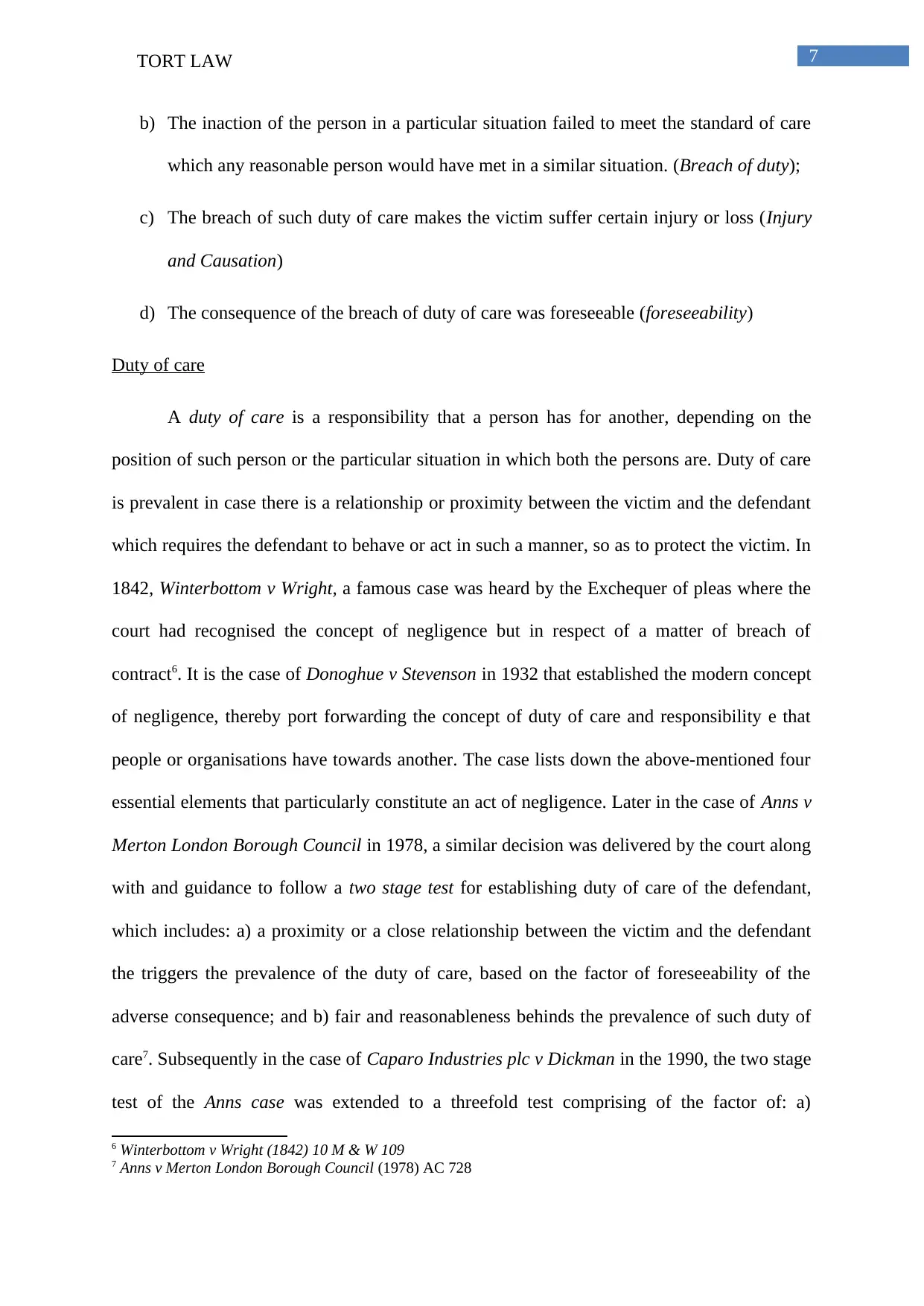
7TORT LAW
b) The inaction of the person in a particular situation failed to meet the standard of care
which any reasonable person would have met in a similar situation. (Breach of duty);
c) The breach of such duty of care makes the victim suffer certain injury or loss (Injury
and Causation)
d) The consequence of the breach of duty of care was foreseeable (foreseeability)
Duty of care
A duty of care is a responsibility that a person has for another, depending on the
position of such person or the particular situation in which both the persons are. Duty of care
is prevalent in case there is a relationship or proximity between the victim and the defendant
which requires the defendant to behave or act in such a manner, so as to protect the victim. In
1842, Winterbottom v Wright, a famous case was heard by the Exchequer of pleas where the
court had recognised the concept of negligence but in respect of a matter of breach of
contract6. It is the case of Donoghue v Stevenson in 1932 that established the modern concept
of negligence, thereby port forwarding the concept of duty of care and responsibility e that
people or organisations have towards another. The case lists down the above-mentioned four
essential elements that particularly constitute an act of negligence. Later in the case of Anns v
Merton London Borough Council in 1978, a similar decision was delivered by the court along
with and guidance to follow a two stage test for establishing duty of care of the defendant,
which includes: a) a proximity or a close relationship between the victim and the defendant
the triggers the prevalence of the duty of care, based on the factor of foreseeability of the
adverse consequence; and b) fair and reasonableness behinds the prevalence of such duty of
care7. Subsequently in the case of Caparo Industries plc v Dickman in the 1990, the two stage
test of the Anns case was extended to a threefold test comprising of the factor of: a)
6 Winterbottom v Wright (1842) 10 M & W 109
7 Anns v Merton London Borough Council (1978) AC 728
b) The inaction of the person in a particular situation failed to meet the standard of care
which any reasonable person would have met in a similar situation. (Breach of duty);
c) The breach of such duty of care makes the victim suffer certain injury or loss (Injury
and Causation)
d) The consequence of the breach of duty of care was foreseeable (foreseeability)
Duty of care
A duty of care is a responsibility that a person has for another, depending on the
position of such person or the particular situation in which both the persons are. Duty of care
is prevalent in case there is a relationship or proximity between the victim and the defendant
which requires the defendant to behave or act in such a manner, so as to protect the victim. In
1842, Winterbottom v Wright, a famous case was heard by the Exchequer of pleas where the
court had recognised the concept of negligence but in respect of a matter of breach of
contract6. It is the case of Donoghue v Stevenson in 1932 that established the modern concept
of negligence, thereby port forwarding the concept of duty of care and responsibility e that
people or organisations have towards another. The case lists down the above-mentioned four
essential elements that particularly constitute an act of negligence. Later in the case of Anns v
Merton London Borough Council in 1978, a similar decision was delivered by the court along
with and guidance to follow a two stage test for establishing duty of care of the defendant,
which includes: a) a proximity or a close relationship between the victim and the defendant
the triggers the prevalence of the duty of care, based on the factor of foreseeability of the
adverse consequence; and b) fair and reasonableness behinds the prevalence of such duty of
care7. Subsequently in the case of Caparo Industries plc v Dickman in the 1990, the two stage
test of the Anns case was extended to a threefold test comprising of the factor of: a)
6 Winterbottom v Wright (1842) 10 M & W 109
7 Anns v Merton London Borough Council (1978) AC 728
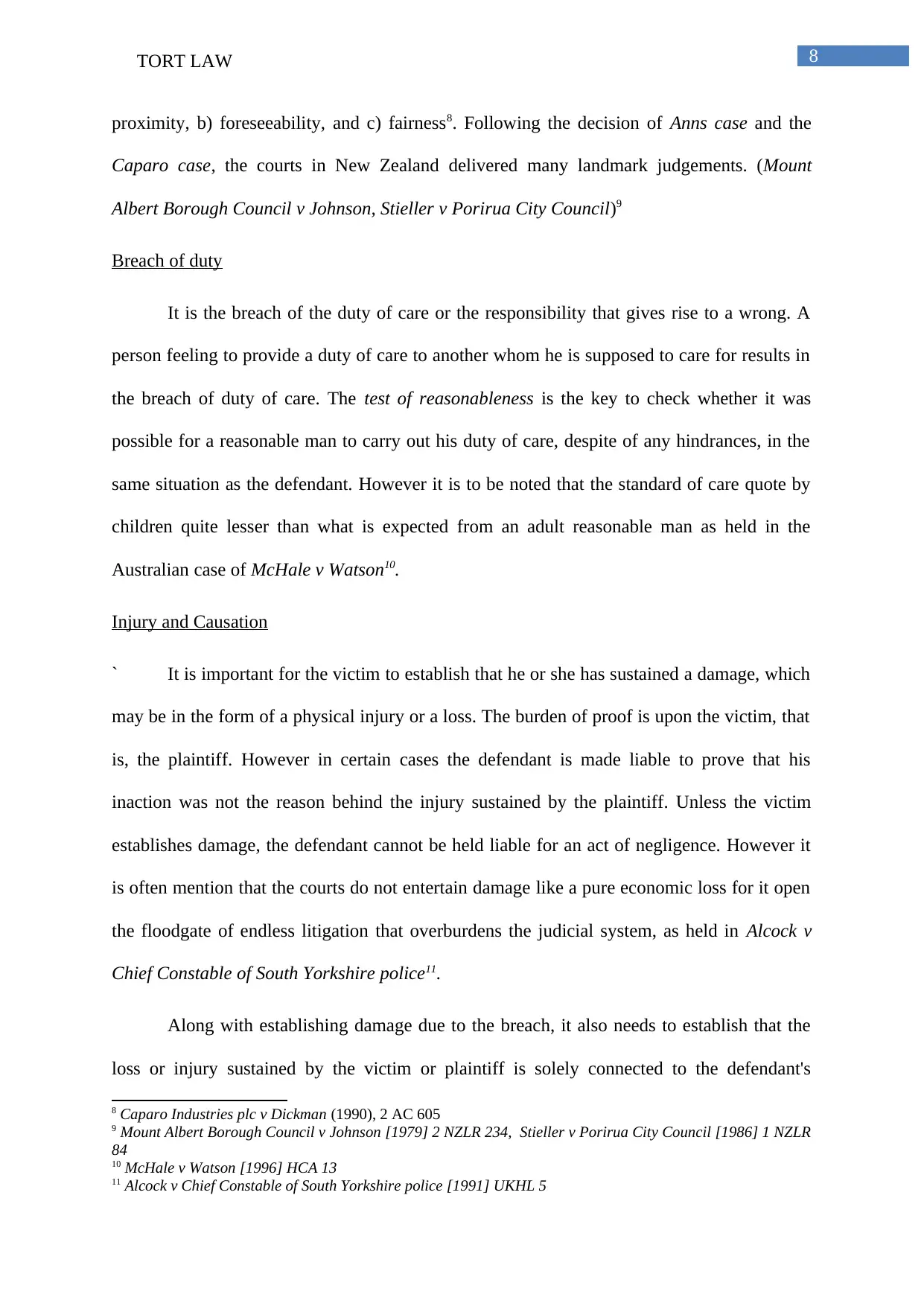
8TORT LAW
proximity, b) foreseeability, and c) fairness8. Following the decision of Anns case and the
Caparo case, the courts in New Zealand delivered many landmark judgements. (Mount
Albert Borough Council v Johnson, Stieller v Porirua City Council)9
Breach of duty
It is the breach of the duty of care or the responsibility that gives rise to a wrong. A
person feeling to provide a duty of care to another whom he is supposed to care for results in
the breach of duty of care. The test of reasonableness is the key to check whether it was
possible for a reasonable man to carry out his duty of care, despite of any hindrances, in the
same situation as the defendant. However it is to be noted that the standard of care quote by
children quite lesser than what is expected from an adult reasonable man as held in the
Australian case of McHale v Watson10.
Injury and Causation
` It is important for the victim to establish that he or she has sustained a damage, which
may be in the form of a physical injury or a loss. The burden of proof is upon the victim, that
is, the plaintiff. However in certain cases the defendant is made liable to prove that his
inaction was not the reason behind the injury sustained by the plaintiff. Unless the victim
establishes damage, the defendant cannot be held liable for an act of negligence. However it
is often mention that the courts do not entertain damage like a pure economic loss for it open
the floodgate of endless litigation that overburdens the judicial system, as held in Alcock v
Chief Constable of South Yorkshire police11.
Along with establishing damage due to the breach, it also needs to establish that the
loss or injury sustained by the victim or plaintiff is solely connected to the defendant's
8 Caparo Industries plc v Dickman (1990), 2 AC 605
9 Mount Albert Borough Council v Johnson [1979] 2 NZLR 234, Stieller v Porirua City Council [1986] 1 NZLR
84
10 McHale v Watson [1996] HCA 13
11 Alcock v Chief Constable of South Yorkshire police [1991] UKHL 5
proximity, b) foreseeability, and c) fairness8. Following the decision of Anns case and the
Caparo case, the courts in New Zealand delivered many landmark judgements. (Mount
Albert Borough Council v Johnson, Stieller v Porirua City Council)9
Breach of duty
It is the breach of the duty of care or the responsibility that gives rise to a wrong. A
person feeling to provide a duty of care to another whom he is supposed to care for results in
the breach of duty of care. The test of reasonableness is the key to check whether it was
possible for a reasonable man to carry out his duty of care, despite of any hindrances, in the
same situation as the defendant. However it is to be noted that the standard of care quote by
children quite lesser than what is expected from an adult reasonable man as held in the
Australian case of McHale v Watson10.
Injury and Causation
` It is important for the victim to establish that he or she has sustained a damage, which
may be in the form of a physical injury or a loss. The burden of proof is upon the victim, that
is, the plaintiff. However in certain cases the defendant is made liable to prove that his
inaction was not the reason behind the injury sustained by the plaintiff. Unless the victim
establishes damage, the defendant cannot be held liable for an act of negligence. However it
is often mention that the courts do not entertain damage like a pure economic loss for it open
the floodgate of endless litigation that overburdens the judicial system, as held in Alcock v
Chief Constable of South Yorkshire police11.
Along with establishing damage due to the breach, it also needs to establish that the
loss or injury sustained by the victim or plaintiff is solely connected to the defendant's
8 Caparo Industries plc v Dickman (1990), 2 AC 605
9 Mount Albert Borough Council v Johnson [1979] 2 NZLR 234, Stieller v Porirua City Council [1986] 1 NZLR
84
10 McHale v Watson [1996] HCA 13
11 Alcock v Chief Constable of South Yorkshire police [1991] UKHL 5
⊘ This is a preview!⊘
Do you want full access?
Subscribe today to unlock all pages.

Trusted by 1+ million students worldwide
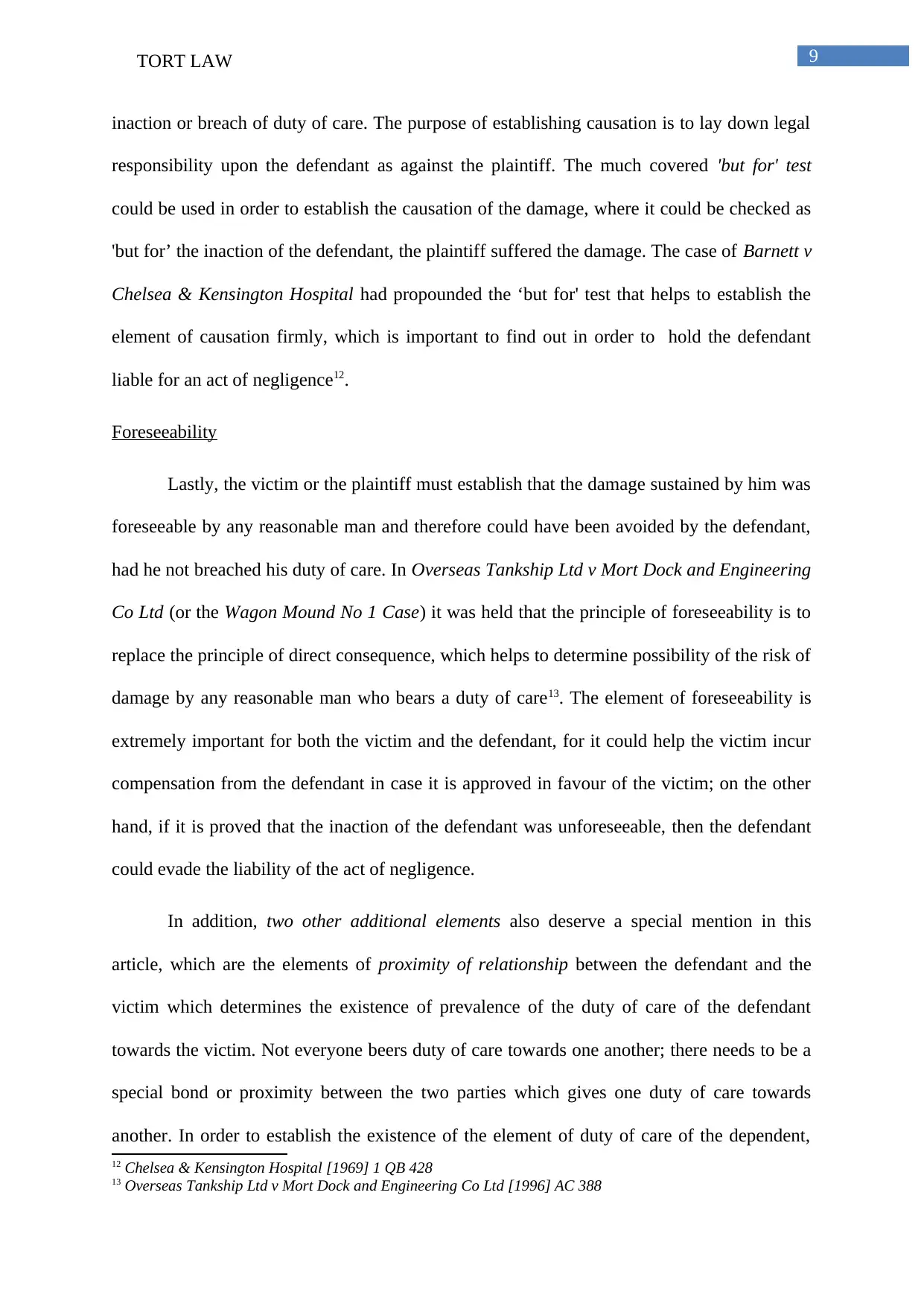
9TORT LAW
inaction or breach of duty of care. The purpose of establishing causation is to lay down legal
responsibility upon the defendant as against the plaintiff. The much covered 'but for' test
could be used in order to establish the causation of the damage, where it could be checked as
'but for’ the inaction of the defendant, the plaintiff suffered the damage. The case of Barnett v
Chelsea & Kensington Hospital had propounded the ‘but for' test that helps to establish the
element of causation firmly, which is important to find out in order to hold the defendant
liable for an act of negligence12.
Foreseeability
Lastly, the victim or the plaintiff must establish that the damage sustained by him was
foreseeable by any reasonable man and therefore could have been avoided by the defendant,
had he not breached his duty of care. In Overseas Tankship Ltd v Mort Dock and Engineering
Co Ltd (or the Wagon Mound No 1 Case) it was held that the principle of foreseeability is to
replace the principle of direct consequence, which helps to determine possibility of the risk of
damage by any reasonable man who bears a duty of care13. The element of foreseeability is
extremely important for both the victim and the defendant, for it could help the victim incur
compensation from the defendant in case it is approved in favour of the victim; on the other
hand, if it is proved that the inaction of the defendant was unforeseeable, then the defendant
could evade the liability of the act of negligence.
In addition, two other additional elements also deserve a special mention in this
article, which are the elements of proximity of relationship between the defendant and the
victim which determines the existence of prevalence of the duty of care of the defendant
towards the victim. Not everyone beers duty of care towards one another; there needs to be a
special bond or proximity between the two parties which gives one duty of care towards
another. In order to establish the existence of the element of duty of care of the dependent,
12 Chelsea & Kensington Hospital [1969] 1 QB 428
13 Overseas Tankship Ltd v Mort Dock and Engineering Co Ltd [1996] AC 388
inaction or breach of duty of care. The purpose of establishing causation is to lay down legal
responsibility upon the defendant as against the plaintiff. The much covered 'but for' test
could be used in order to establish the causation of the damage, where it could be checked as
'but for’ the inaction of the defendant, the plaintiff suffered the damage. The case of Barnett v
Chelsea & Kensington Hospital had propounded the ‘but for' test that helps to establish the
element of causation firmly, which is important to find out in order to hold the defendant
liable for an act of negligence12.
Foreseeability
Lastly, the victim or the plaintiff must establish that the damage sustained by him was
foreseeable by any reasonable man and therefore could have been avoided by the defendant,
had he not breached his duty of care. In Overseas Tankship Ltd v Mort Dock and Engineering
Co Ltd (or the Wagon Mound No 1 Case) it was held that the principle of foreseeability is to
replace the principle of direct consequence, which helps to determine possibility of the risk of
damage by any reasonable man who bears a duty of care13. The element of foreseeability is
extremely important for both the victim and the defendant, for it could help the victim incur
compensation from the defendant in case it is approved in favour of the victim; on the other
hand, if it is proved that the inaction of the defendant was unforeseeable, then the defendant
could evade the liability of the act of negligence.
In addition, two other additional elements also deserve a special mention in this
article, which are the elements of proximity of relationship between the defendant and the
victim which determines the existence of prevalence of the duty of care of the defendant
towards the victim. Not everyone beers duty of care towards one another; there needs to be a
special bond or proximity between the two parties which gives one duty of care towards
another. In order to establish the existence of the element of duty of care of the dependent,
12 Chelsea & Kensington Hospital [1969] 1 QB 428
13 Overseas Tankship Ltd v Mort Dock and Engineering Co Ltd [1996] AC 388
Paraphrase This Document
Need a fresh take? Get an instant paraphrase of this document with our AI Paraphraser
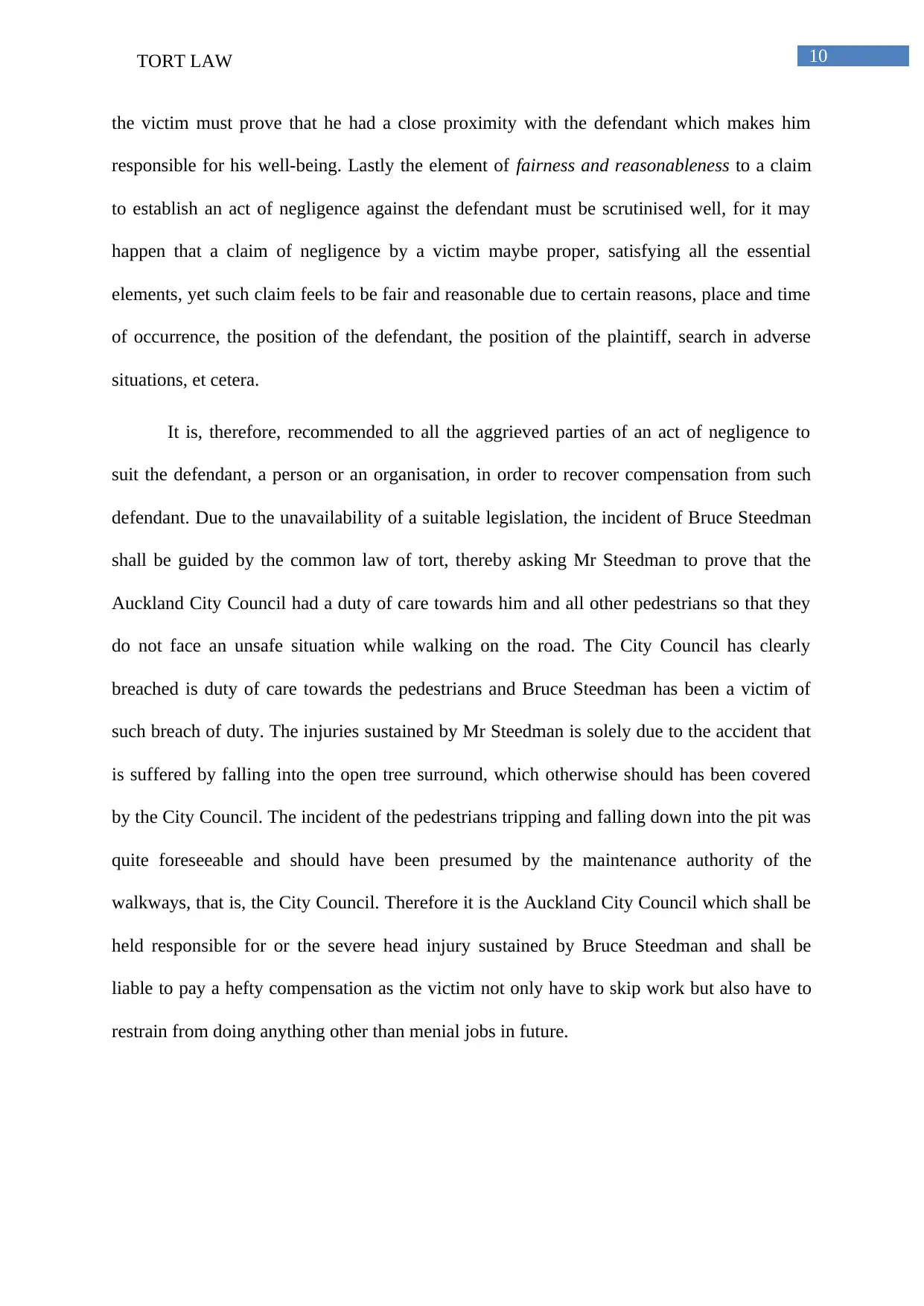
10TORT LAW
the victim must prove that he had a close proximity with the defendant which makes him
responsible for his well-being. Lastly the element of fairness and reasonableness to a claim
to establish an act of negligence against the defendant must be scrutinised well, for it may
happen that a claim of negligence by a victim maybe proper, satisfying all the essential
elements, yet such claim feels to be fair and reasonable due to certain reasons, place and time
of occurrence, the position of the defendant, the position of the plaintiff, search in adverse
situations, et cetera.
It is, therefore, recommended to all the aggrieved parties of an act of negligence to
suit the defendant, a person or an organisation, in order to recover compensation from such
defendant. Due to the unavailability of a suitable legislation, the incident of Bruce Steedman
shall be guided by the common law of tort, thereby asking Mr Steedman to prove that the
Auckland City Council had a duty of care towards him and all other pedestrians so that they
do not face an unsafe situation while walking on the road. The City Council has clearly
breached is duty of care towards the pedestrians and Bruce Steedman has been a victim of
such breach of duty. The injuries sustained by Mr Steedman is solely due to the accident that
is suffered by falling into the open tree surround, which otherwise should has been covered
by the City Council. The incident of the pedestrians tripping and falling down into the pit was
quite foreseeable and should have been presumed by the maintenance authority of the
walkways, that is, the City Council. Therefore it is the Auckland City Council which shall be
held responsible for or the severe head injury sustained by Bruce Steedman and shall be
liable to pay a hefty compensation as the victim not only have to skip work but also have to
restrain from doing anything other than menial jobs in future.
the victim must prove that he had a close proximity with the defendant which makes him
responsible for his well-being. Lastly the element of fairness and reasonableness to a claim
to establish an act of negligence against the defendant must be scrutinised well, for it may
happen that a claim of negligence by a victim maybe proper, satisfying all the essential
elements, yet such claim feels to be fair and reasonable due to certain reasons, place and time
of occurrence, the position of the defendant, the position of the plaintiff, search in adverse
situations, et cetera.
It is, therefore, recommended to all the aggrieved parties of an act of negligence to
suit the defendant, a person or an organisation, in order to recover compensation from such
defendant. Due to the unavailability of a suitable legislation, the incident of Bruce Steedman
shall be guided by the common law of tort, thereby asking Mr Steedman to prove that the
Auckland City Council had a duty of care towards him and all other pedestrians so that they
do not face an unsafe situation while walking on the road. The City Council has clearly
breached is duty of care towards the pedestrians and Bruce Steedman has been a victim of
such breach of duty. The injuries sustained by Mr Steedman is solely due to the accident that
is suffered by falling into the open tree surround, which otherwise should has been covered
by the City Council. The incident of the pedestrians tripping and falling down into the pit was
quite foreseeable and should have been presumed by the maintenance authority of the
walkways, that is, the City Council. Therefore it is the Auckland City Council which shall be
held responsible for or the severe head injury sustained by Bruce Steedman and shall be
liable to pay a hefty compensation as the victim not only have to skip work but also have to
restrain from doing anything other than menial jobs in future.
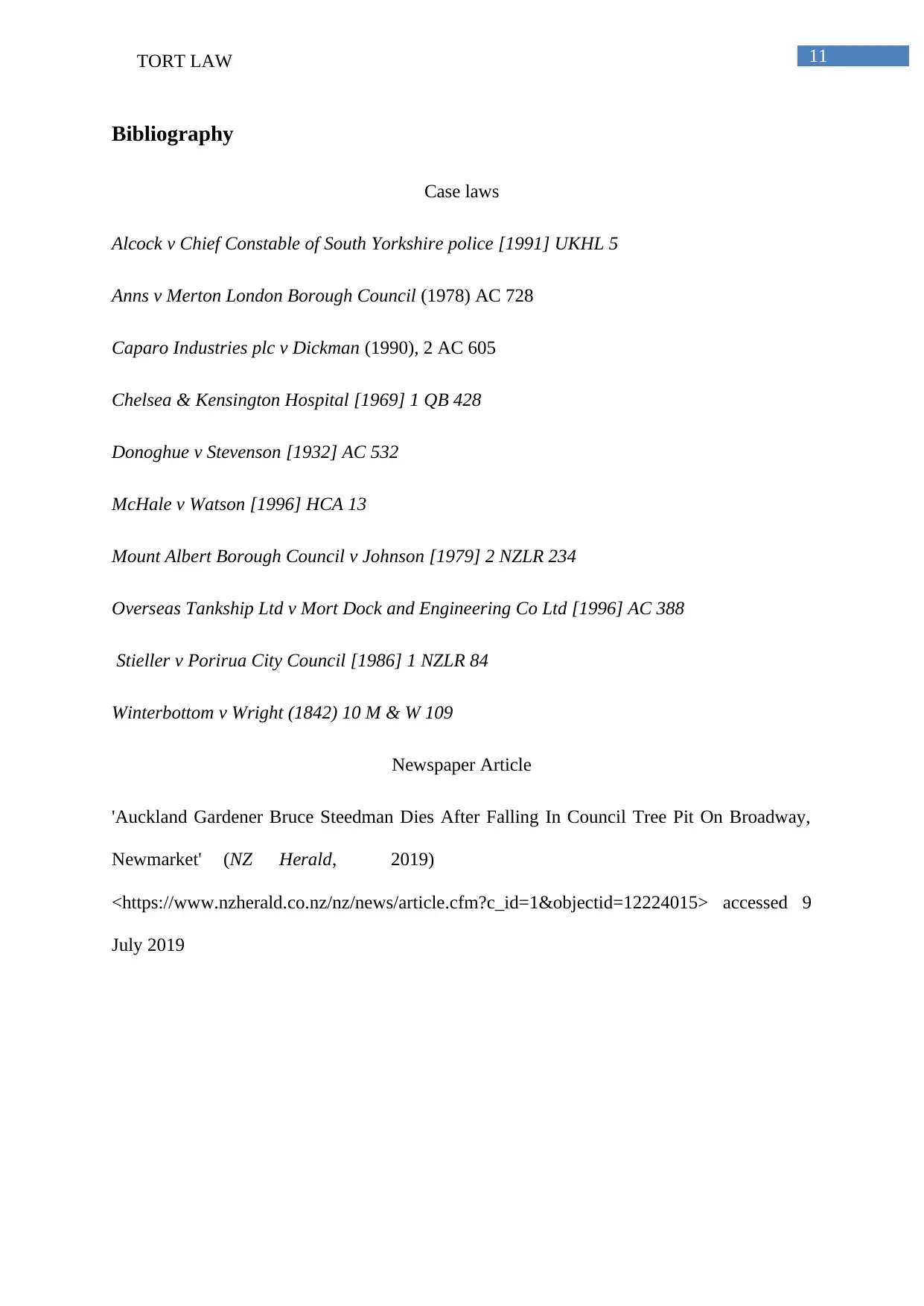
11TORT LAW
Bibliography
Case laws
Alcock v Chief Constable of South Yorkshire police [1991] UKHL 5
Anns v Merton London Borough Council (1978) AC 728
Caparo Industries plc v Dickman (1990), 2 AC 605
Chelsea & Kensington Hospital [1969] 1 QB 428
Donoghue v Stevenson [1932] AC 532
McHale v Watson [1996] HCA 13
Mount Albert Borough Council v Johnson [1979] 2 NZLR 234
Overseas Tankship Ltd v Mort Dock and Engineering Co Ltd [1996] AC 388
Stieller v Porirua City Council [1986] 1 NZLR 84
Winterbottom v Wright (1842) 10 M & W 109
Newspaper Article
'Auckland Gardener Bruce Steedman Dies After Falling In Council Tree Pit On Broadway,
Newmarket' (NZ Herald, 2019)
<https://www.nzherald.co.nz/nz/news/article.cfm?c_id=1&objectid=12224015> accessed 9
July 2019
Bibliography
Case laws
Alcock v Chief Constable of South Yorkshire police [1991] UKHL 5
Anns v Merton London Borough Council (1978) AC 728
Caparo Industries plc v Dickman (1990), 2 AC 605
Chelsea & Kensington Hospital [1969] 1 QB 428
Donoghue v Stevenson [1932] AC 532
McHale v Watson [1996] HCA 13
Mount Albert Borough Council v Johnson [1979] 2 NZLR 234
Overseas Tankship Ltd v Mort Dock and Engineering Co Ltd [1996] AC 388
Stieller v Porirua City Council [1986] 1 NZLR 84
Winterbottom v Wright (1842) 10 M & W 109
Newspaper Article
'Auckland Gardener Bruce Steedman Dies After Falling In Council Tree Pit On Broadway,
Newmarket' (NZ Herald, 2019)
<https://www.nzherald.co.nz/nz/news/article.cfm?c_id=1&objectid=12224015> accessed 9
July 2019
⊘ This is a preview!⊘
Do you want full access?
Subscribe today to unlock all pages.

Trusted by 1+ million students worldwide
1 out of 12
Your All-in-One AI-Powered Toolkit for Academic Success.
+13062052269
info@desklib.com
Available 24*7 on WhatsApp / Email
![[object Object]](/_next/static/media/star-bottom.7253800d.svg)
Unlock your academic potential
Copyright © 2020–2025 A2Z Services. All Rights Reserved. Developed and managed by ZUCOL.

